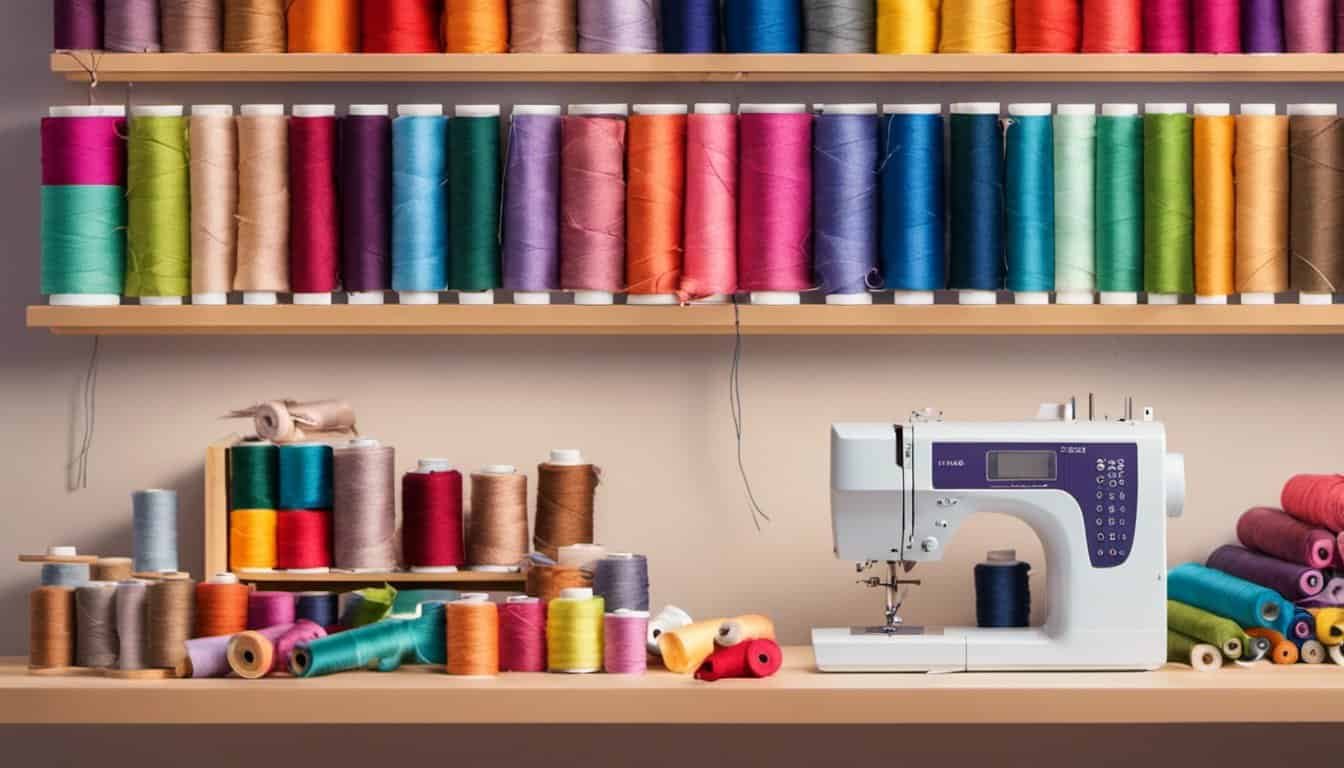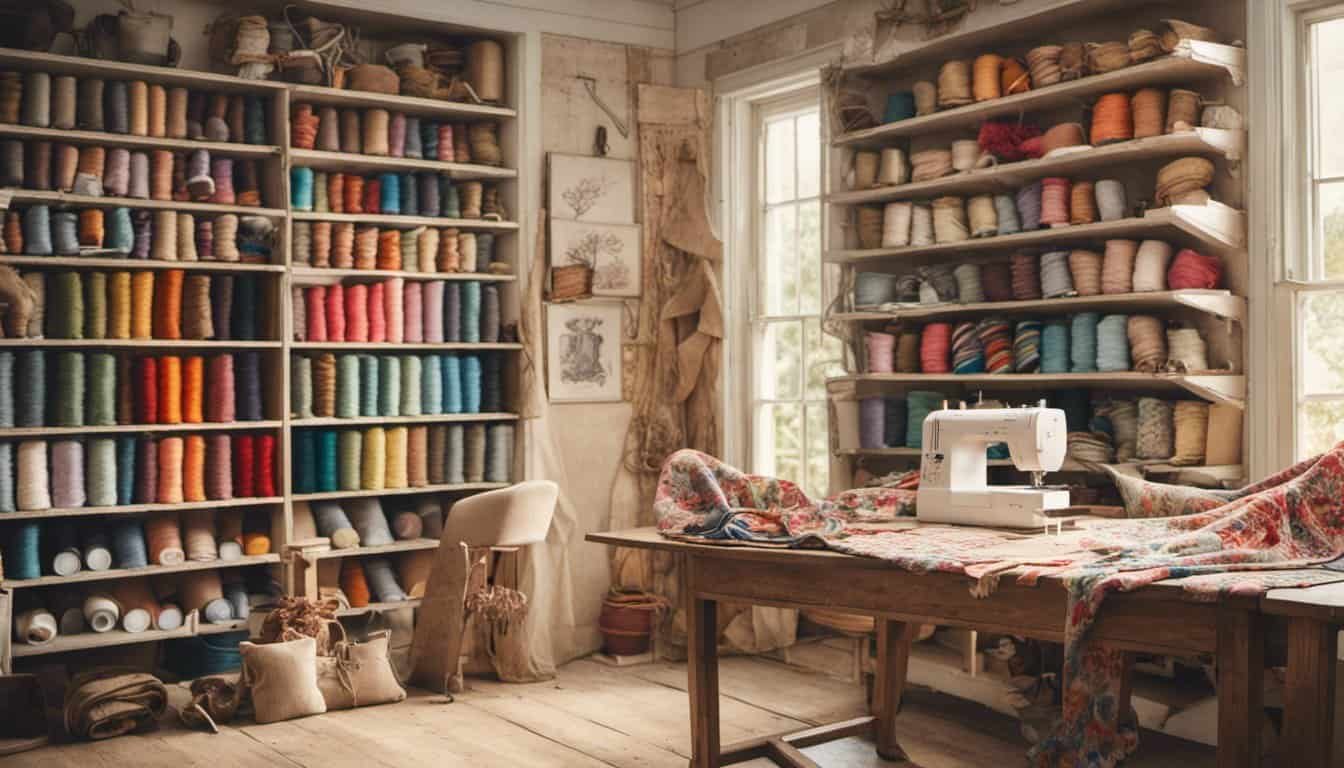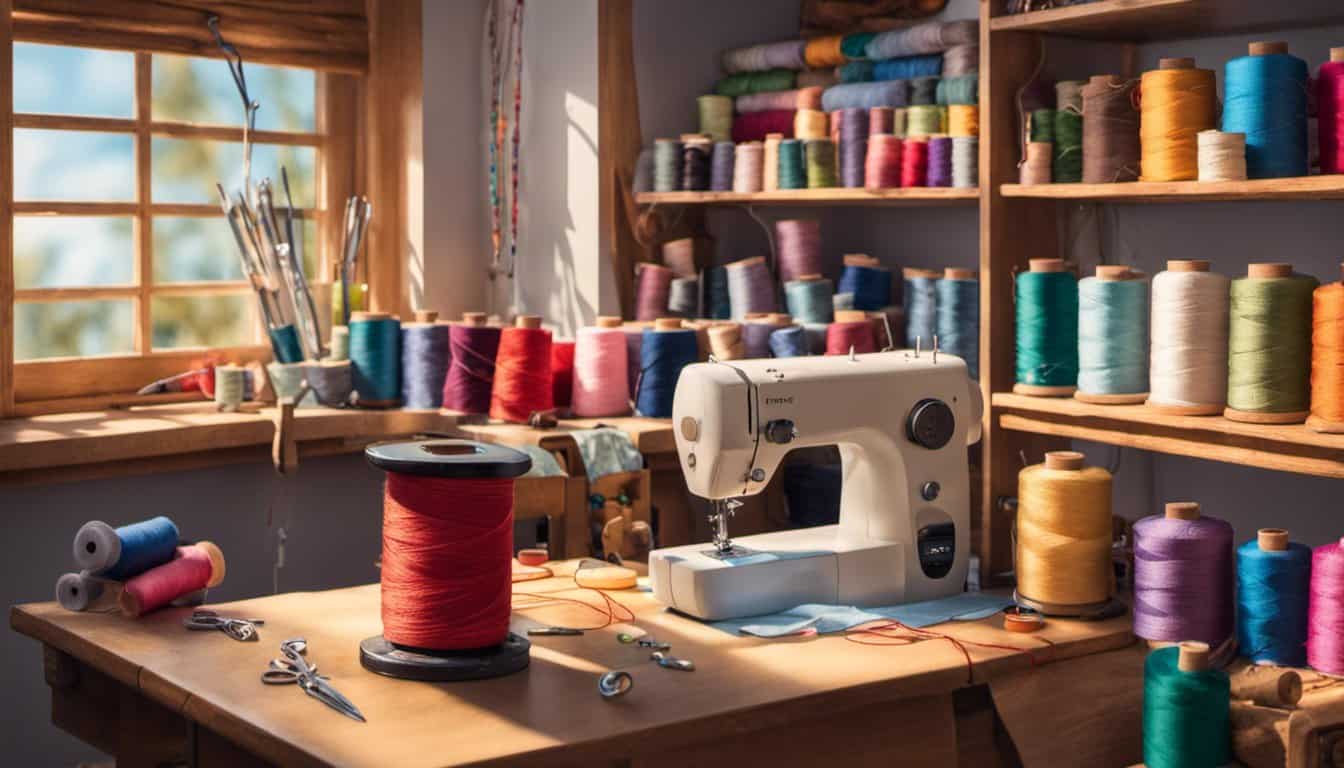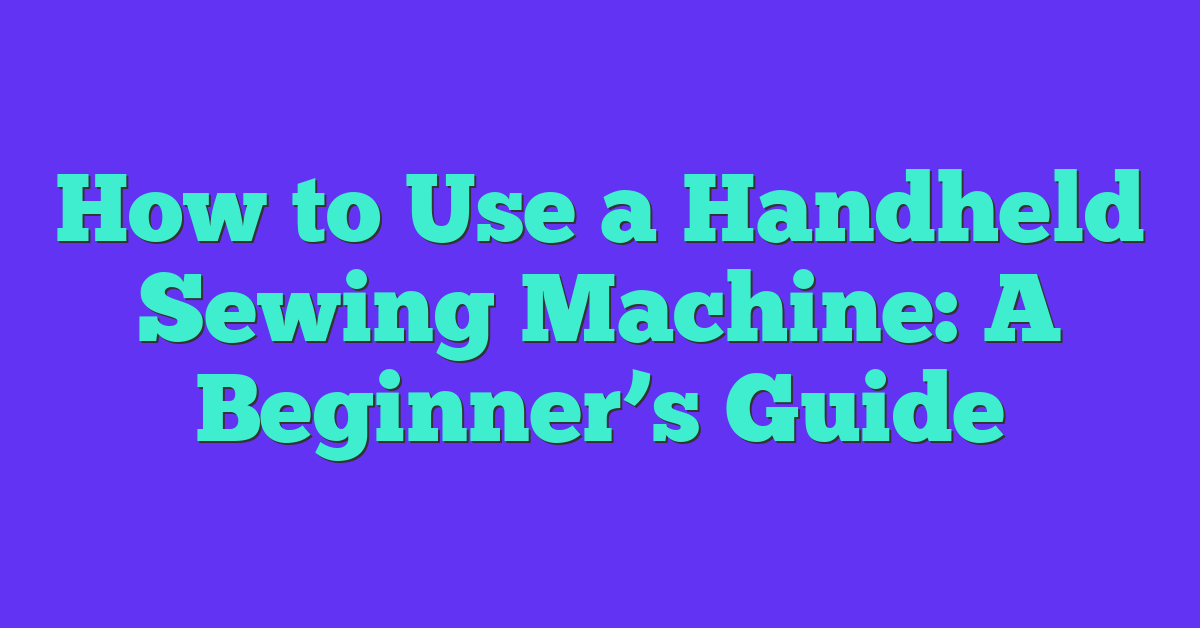Using a handheld sewing machine can be a fun and convenient way to complete small sewing projects. Whether you’re a beginner or an experienced sewer, a handheld sewing machine can help you quickly stitch fabric together without the need for a traditional sewing machine. In this article, I will provide step-by-step instructions on how to use a handheld sewing machine, from understanding its parts to practicing with it.
To start, it’s important to understand the different parts of a handheld sewing machine, such as the spool holder, tension control, and needle. Once you have a good understanding of the machine’s parts, you can set it up and thread it properly. Choosing the right fabric and needle is also important to ensure that your stitches are strong and durable. Additionally, there are various sewing techniques that you can use with a handheld sewing machine, such as backstitching and basting.
Overall, using a handheld sewing machine can be a great way to complete small sewing projects quickly and easily. With the right knowledge and practice, you can become proficient in using a handheld sewing machine and enjoy the benefits it has to offer.
Key Takeaways
- Understanding the parts of a handheld sewing machine is important for successful use.
- Threading the machine properly and choosing the right fabric and needle are crucial steps.
- Practicing sewing techniques with a handheld machine can help you become proficient in using it.
Understanding Your Handheld Sewing Machine
As someone who loves sewing, I find handheld sewing machines to be a convenient tool to have in my sewing kit. They are small, lightweight, and portable, making them perfect for quick repairs, hemming, and small sewing projects. In this section, I will share some of my knowledge about handheld sewing machines to help you understand them better.
Battery-operated
Most handheld sewing machines use batteries to operate, usually AA batteries. Before using your machine, make sure to load the batteries according to the instructions in the manual. Some machines have a power button that you need to turn on before you can start sewing. It is also important to keep extra batteries on hand in case the ones in the machine run out.
Portable and lightweight
One of the biggest advantages of a handheld sewing machine is its portability. It is small and compact, making it easy to carry around with you wherever you go. You can take it with you on vacations, to sewing classes, or even to work. Its lightweight design makes it easy to handle, even for beginners.
Easy to use
Handheld sewing machines are easy to use, even if you have never sewn before. They usually come with a manual that explains how to operate them. It is important to read the manual carefully before using the machine, especially if you are new to sewing.
Inexpensive
Compared to regular sewing machines, handheld sewing machines are relatively inexpensive. They are a great option for beginners who do not want to invest in a more expensive machine right away. They are also a great tool for experienced sewers who want a portable and convenient option for quick repairs.
Types of handheld sewing machines
There are several types of handheld sewing machines available in the market. Singer and Sunbeam are two popular brands that make handheld sewing machines. Some machines are designed specifically for small projects, while others can handle larger projects. Mini sewing machines and compact sewing machines are also available for those who want a more permanent solution.
In conclusion, a handheld sewing machine is a convenient tool for anyone who loves sewing. It is small, portable, easy to use, and relatively inexpensive. Understanding how to use your machine properly will help you get the most out of it and make your sewing projects a success.
Setting Up Your Handheld Sewing Machine
Before using your handheld sewing machine, it’s important to properly set it up. Here are the steps to follow:
Load batteries: Most handheld sewing machines use batteries to operate. Check the manual to see how many batteries you need to insert. Use a screwdriver if necessary to open the battery compartment. Insert the batteries according to the instructions and close the compartment.
Thread the machine: Follow the instructions in the manual to thread the machine. Make sure the spindle is in place and the spool pin is inserted correctly.
Turn on the machine: Locate the switch on the machine and turn it on. The needle arm should start moving back and forth.
Check the tension: The tension mechanism controls the tightness of the thread as it passes through the machine. Check the manual to see how to adjust the tension.
Test the machine: Place a piece of fabric under the needle and press the foot pedal or use the on/off switch to start sewing. Check that the thread is being pulled from the spool and passing through the needle eye correctly.
Adjust the stitch length: Depending on the model, you may be able to adjust the stitch length. Check the manual for instructions on how to do this.
Secure the thread: After finishing your sewing, make sure to secure the thread by using the fastening plate or other mechanism provided by the machine.
By following these steps, you should be able to properly set up your handheld sewing machine and start using it for all your sewing needs.
Threading Your Handheld Sewing Machine
Threading a handheld sewing machine can be a bit tricky, but with a little practice, it becomes easier. In this section, I will guide you through the process of threading your handheld sewing machine.
Step 1: Load the Bobbin
The first step in threading your handheld sewing machine is to load the bobbin. Refer to the manual of your specific handheld sewing machine to load the spool into the sewing machine, ensuring that it will come off counterclockwise. Once the spool is loaded, have the thread up and through the designated guide for it.
Step 2: Thread the Needle
The next step is to thread the needle. Take the end of the thread and pass it through the eye of the needle from left to right. If you are having trouble threading the needle, try moistening the end of the thread with your fingers or using a needle threader.
Step 3: Knot the Thread
After threading the needle, tie a knot at the end of the thread to prevent it from slipping through the fabric. To tie a knot, take the end of the thread and wrap it around your finger. Then, roll the thread off your finger and pinch the loop that forms. Pull the loop through the pinch and tighten the knot.
Step 4: Assemble the Tensioner
If your handheld sewing machine comes with the tensioner assembled, you can skip this step. Otherwise, assemble the tensioner according to the instructions in the manual.
Step 5: Thread the Handheld Sewing Machine
Now it’s time to thread the handheld sewing machine. Start by passing the thread through the tensioner and then through the hook under the needle arm. Next, pass the thread through the needle from left to right. Finally, pull the thread through the needle until you have about six inches of thread hanging from the needle.

Congratulations! You have successfully threaded your handheld sewing machine. With a little practice, you will be able to thread your sewing machine quickly and easily.
Choosing the Right Fabric and Needle
When it comes to choosing the right fabric and needle for your handheld sewing machine, there are a few things to keep in mind. First, consider the type of fabric you will be working with. Different fabrics require different types of needles, so it’s important to choose the appropriate needle size and type for the material.
For lightweight fabrics such as silk or cotton, a universal needle with a size of 70/10 or 80/12 is a good choice. For medium-weight fabrics like denim or wool, a size 90/14 or 100/16 needle is appropriate. It’s important to use the appropriate needle size for your fabric to avoid damaging the fabric or breaking the needle.
When working with heavier fabrics like denim or wool, it’s important to use a needle specifically designed for these materials. A denim needle has a sharp point and is designed to penetrate through thick layers of fabric. A wool needle has a slightly rounded point and is designed to prevent snagging or damaging delicate wool fibers.
« Sewing Machines Available on Amazon: Your Ultimate Guide to Finding the Best One for You
Brother RSQ9185 Review: The Ultimate Sewing Machine for Your DIY Projects »
It’s also important to consider the type of thread you will be using. A thicker thread requires a larger needle size, while a thinner thread requires a smaller needle size. Be sure to choose a thread that is appropriate for your fabric and needle.
In summary, choosing the right fabric and needle for your handheld sewing machine is essential for achieving professional-looking results. By selecting the appropriate needle size and type for your fabric, you can avoid damaging the material and ensure a smooth sewing experience.
Sewing Techniques with Handheld Machine
When it comes to sewing with a handheld machine, there are a few techniques that you need to master to achieve the best results. Here are some tips that I have found helpful:
Tension Control
Tension control is crucial for achieving a good stitch with a handheld sewing machine. Most machines come with a tension knob that you can adjust to increase or decrease the tension. It’s important to find the right balance of tension for the fabric you are working with. If the tension is too tight, the stitches will be too small and may pucker the fabric. If the tension is too loose, the stitches will be too loose and may result in a weak seam.
Straight Stitch
The straight stitch is the most basic stitch that you can create with a handheld sewing machine. It’s perfect for simple repairs and hemming. To create a straight stitch, simply guide the fabric through the machine while holding it taut. Make sure to keep the machine moving at a steady pace to avoid uneven stitching.
Chain Stitch
The chain stitch is a decorative stitch that you can use to add a bit of flair to your sewing projects. It’s created by looping the thread back through the previous stitch to create a chain-like effect. To create a chain stitch, simply sew a straight stitch, then pull the thread through the loop and back through the fabric. Repeat this process to create a chain of stitches.

Backstitch
The backstitch is a strong stitch that you can use for seams that need extra reinforcement. It’s created by sewing forward a few stitches, then sewing back over the same stitches to create a double line of stitching. To create a backstitch, simply sew forward a few stitches, then reverse direction and sew back over the same stitches.
Tear
If you make a mistake while sewing with a handheld machine, don’t worry! You can easily tear out the stitches and start again. Simply use a seam ripper or small scissors to cut the stitches, then gently pull the thread out of the fabric.
These are just a few of the sewing techniques that you can use with a handheld sewing machine. With a bit of practice, you’ll be creating beautiful stitches in no time!
Troubleshooting Common Issues
As with any sewing machine, there are common issues that can arise with a handheld sewing machine. Here are some tips on how to troubleshoot these issues:
Thread Tension Issues
One common issue is thread tension. If your stitches are too loose or too tight, you may need to adjust the tension. Most handheld sewing machines have tension disks that can be adjusted. To do this, turn the tension adjustment knob (usually located near the needle) clockwise to increase tension and counterclockwise to decrease tension.

If adjusting the tension doesn’t work, you may need to re-thread the machine. Make sure the thread is properly threaded through all the guides and the needle. Also, check that the bobbin is properly inserted and that the thread is wound onto the bobbin evenly.
Needle Issues
Another common issue is a malfunctioning needle. If your machine is not stitching properly, check the needle. Make sure it is inserted correctly, with the flat side facing the back of the machine. Also, make sure the needle is the correct size for the fabric you are using.
If the needle is bent or dull, replace it with a new one. It’s important to change the needle regularly, as a dull or bent needle can cause the machine to skip stitches or break the thread.
Other Issues
If you’re still having issues with your handheld sewing machine, there are a few other things to check. First, make sure the machine is properly lubricated. Check the manual for instructions on how to oil the machine.
If the machine is still not working properly, it may be a mechanical issue. In this case, it’s best to take the machine to a professional for repair.

By following these troubleshooting tips, you can keep your handheld sewing machine running smoothly and avoid frustration when things go wrong.
Maintenance and Care for Your Handheld Sewing Machine
Taking care of your handheld sewing machine is essential to ensure its longevity and optimal performance. Here are some tips on how to maintain and care for your handheld sewing machine:
Cleaning
Regular cleaning is essential to keep your machine running smoothly. After each use, remove the needle and clean the bobbin area with a brush or a lint roller. Use a soft cloth to wipe the machine’s exterior and remove any dust or debris.
Lubrication
Lubrication is crucial to prevent your machine from rusting and to keep it running smoothly. Apply a drop of oil to the needle and bobbin area after every use. Use only a small amount of oil, as an excess can attract dust and lint.
Testing
Before using your handheld sewing machine, always perform a test run on a scrap of fabric. This will help you ensure that the machine is running correctly and that the tension is set correctly.

Maintenance
Regular maintenance is necessary to keep your handheld sewing machine in top condition. Check the machine’s manual for specific instructions on how to maintain your machine. Some machines may require periodic adjustments or repairs, so it’s essential to stay on top of maintenance to avoid costly repairs.
Storage
When you’re not using your handheld sewing machine, it’s essential to store it correctly. Keep it in a dry, cool place, and cover it with a dust cover to prevent dust and debris from accumulating on the machine.
By following these tips, you can ensure that your handheld sewing machine stays in top condition and performs optimally for years to come.
Practicing with Your Handheld Sewing Machine
Now that I have learned the basics of how to use a handheld sewing machine, it’s time to practice! I find that practicing with my machine is the best way to get comfortable with its features and functions.
To start practicing, I like to create a loop with my thread and place it around the presser foot. This helps me get a feel for the machine’s tension control knob and how it affects the stitching.

As a beginner, I find it helpful to watch video tutorials and follow step-by-step guides. There are many resources available online that provide straightforward instructions on how to use a handheld sewing machine.
When practicing, I like to start with simple crafts like hemming pants or creating small patches. This allows me to focus on the basics of stitching and get comfortable with the machine’s movement.
One helpful tool for beginners is a diagram of the machine’s parts and functions. This can be found in the instruction manual or online. Having a visual reference can make it easier to understand how the machine works.
Finally, I find that effort and patience are key when practicing with a handheld sewing machine. It may take some time to get the hang of it, but with practice, I know I can master this useful tool for my crafting projects.
Benefits of Using a Handheld Sewing Machine
As someone who has used a handheld sewing machine for a while now, I can attest to its numerous benefits. Here are some of the reasons why I find it an indispensable tool for quick repairs and handy stitches:

Fast and Easy to Use
One of the biggest advantages of a handheld sewing machine is its speed and ease of use. Unlike traditional sewing machines, which require a lot of setup time and can be intimidating for beginners, handheld machines are ready to use straight out of the box. They are also much faster than hand sewing, making them ideal for quick repairs and small projects.
Affordable and Durable
Handheld sewing machines are also much more affordable than traditional sewing machines, making them a great choice for those on a budget or who only need to do occasional repairs. Despite their low cost, they are surprisingly durable and can last for years with proper care.
Handy Stitching
Another benefit of handheld sewing machines is their ability to perform handy stitches. Whether you need to hem a pair of pants, fix a tear in a shirt, or sew a patch onto a backpack, a handheld machine can quickly and easily get the job done.
Portable and Convenient
Perhaps the biggest advantage of a handheld sewing machine is its portability and convenience. Unlike traditional sewing machines, which are bulky and require a dedicated workspace, handheld machines can be used anywhere. They are perfect for taking on the go, whether you need to do repairs while traveling or want to work on a project in a coffee shop.
Overall, I believe that a handheld sewing machine is an essential tool for anyone who needs to do quick repairs or handy stitching. Its speed, affordability, durability, and convenience make it an indispensable part of my sewing toolkit.

Comparing Handheld and Traditional Sewing Machines
When it comes to sewing machines, there are two main types: handheld and traditional. As someone who has used both, I can say that each has its own advantages and disadvantages.
Handheld Sewing Machines
Handheld sewing machines are small, portable, and easy to use. They are great for small projects or quick repairs, and they don’t take up much space. They are also generally less expensive than traditional sewing machines.
However, there are some downsides to handheld sewing machines. They are not as powerful as traditional machines, so they can’t handle heavy-duty fabrics or large projects. They also require more manual dexterity, as you have to hold the fabric and guide it through the machine at the same time.
Traditional Sewing Machines
Traditional sewing machines are larger, more powerful, and more versatile than handheld machines. They can handle a wider range of fabrics and projects, and they have more features and options.
However, traditional sewing machines are also more expensive and take up more space. They can be more complicated to use, especially for beginners, and they require more maintenance.

In summary, handheld sewing machines are great for small, quick projects and repairs, while traditional sewing machines are better for larger, more complex projects. It really depends on your needs and preferences.
Frequently Asked Questions
What are some tips for using a handheld sewing machine effectively?
When using a handheld sewing machine, it is important to keep a few tips in mind to make the process go more smoothly. First, make sure to read the instruction manual carefully before beginning. This will help you understand the different parts of the machine and how to use them. Second, practice on scrap fabric before beginning your actual project. This will help you get a feel for the machine and how it works. Finally, make sure to maintain your machine by cleaning it regularly and storing it properly.
Can a beginner use a handheld sewing machine?
Yes, a beginner can definitely use a handheld sewing machine. In fact, many handheld machines are marketed towards beginners because they are easy to use and don’t require a lot of setup or maintenance. Just make sure to read the instruction manual carefully and practice on scrap fabric before beginning your actual project.
What is the price range for a handheld sewing machine?
The price range for a handheld sewing machine can vary depending on the brand and features. Generally, you can expect to pay anywhere from $15 to $50 for a handheld machine. Some more advanced models may cost more.
What are the benefits of using a handheld sewing machine?
One of the main benefits of using a handheld sewing machine is that it is portable and easy to use. You can take it with you wherever you go and use it to quickly make repairs or alterations. Additionally, handheld machines are often less expensive than traditional sewing machines and require less setup and maintenance.

How do you thread a handheld sewing machine?
Threading a handheld sewing machine can vary depending on the specific model, so it is important to consult the instruction manual for your machine. Generally, you will need to insert the thread through the needle and then through the tension mechanism. Finally, you will need to thread the bobbin and insert it into the machine.
Are there any safety tips to keep in mind when using a handheld sewing machine?
Yes, there are a few safety tips to keep in mind when using a handheld sewing machine. First, make sure to always unplug the machine when not in use. Additionally, be careful when handling the needle and keep your fingers away from the sewing area. Finally, make sure to use the machine on a stable surface to prevent it from slipping or falling.


















